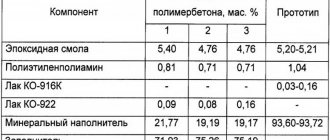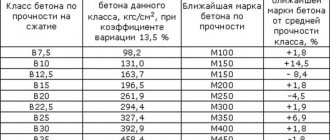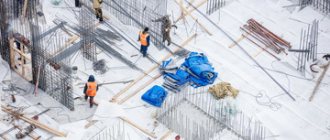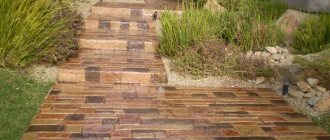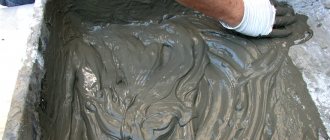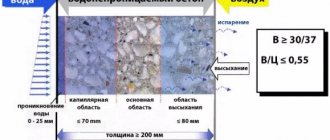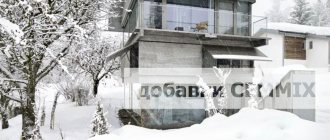Concrete is classified according to the type of binder used:
on inorganic binders (cement concrete, gypsum concrete, silicate, acid-resistant, heat-resistant and other special binders) and binders on organic binders (asphalt concrete, plastic concrete).
Cement concrete, depending on the volumetric mass (in kg/m3), is divided into extra-heavy (more than 2500), heavy (from 1800 to 2500), light (from 500 to 1800) and extra-light (less than 500).
Extra-heavy concrete is intended for special protective structures (against radioactive influences); they are made primarily using Portland cement and natural or artificial fillers (magnetite, limonite, barite, cast iron scrap, rebar scraps). To improve the protective properties against neutron radiation, boron carbide or other additives containing light elements - hydrogen, lithium, cadmium - are usually added to especially heavy concrete.
The most common are heavy concretes used in reinforced concrete and concrete structures of industrial and civil buildings, in hydraulic structures, in the construction of canals, transport and other structures. Of particular importance in hydraulic engineering is resistance to exposure to sea and fresh water and the atmosphere.
Fillers for heavy concrete are subject to special requirements for particle size distribution and purity. The harsh climatic conditions of a number of regions of the Soviet Union led to the need to develop and implement winter concreting methods. In areas with a temperate climate, the processes of accelerating the hardening of concrete are of great importance, which is achieved by using quickly hardening cements, heat treatment (electric heating, steaming, autoclave treatment), introducing chemical additives, and other methods. Heavy concrete also includes silicate concrete, in which calcium lime is the binder. An intermediate position between heavy and light is occupied by coarse-porous (sand-free) concrete, made on dense coarse aggregate with cement stone porous with the help of gas or foaming agents.
Lightweight concrete is made using hydraulic binder and porous artificial or natural aggregates. There are many varieties of lightweight concrete; they are named depending on the type of aggregate used - vermiculite concrete, expanded clay concrete, pumice concrete, perlite concrete, tuff concrete, etc.
According to the structure and degree of filling of the intergranular space with cement stone, light concretes are divided into ordinary light ones (with complete filling of the intergranular space), low-sand light ones (with partial filling of the intergranular space), large-porous light ones produced without fine aggregate, and lightweight concrete with cement stone, porous with gas or foaming agents.
Based on the type of binder, lightweight concretes on porous aggregates are divided into cement, cement-lime, lime-slag and silicate.
A rational area of application for lightweight concrete is external walls and coatings of buildings where low thermal conductivity and low weight are required. High-strength lightweight is used in load-bearing structures of industrial and civil buildings (in order to reduce their own weight). Lightweight concrete also includes structural-thermal-insulating and structural cellular concrete with a volumetric mass from 500 to 1200 kg/m3. According to the method of formation of the porous structure, cellular concrete is divided into aerated concrete and foam concrete, and according to the type of binder - into aerated and foam concrete produced using Portland cement or mixed binders; for gas and foam silicates produced on the basis of lime; gas and foam slag concrete using ground blast furnace slag.
When using ash instead of quartz sand, cellular concrete is called gas and foam ash concrete, gas and foam ash silicate, gas and foam slag concrete.
Particularly lightweight concrete is used mainly as thermal insulation materials.
The areas of application of concrete in modern construction are constantly expanding.
In the future, it is planned to use high-strength concrete (heavy and light), as well as with specified physical and technical properties: low shrinkage and creep, frost resistance, durability, crack resistance, thermal conductivity, heat resistance and protective properties from radioactive influences. To achieve this, it will be necessary to carry out a wide range of studies involving the development of the most important theoretical issues of heavy, light and cellular technology: macro- and microstructural theories of concrete strength taking into account internal stresses and microcrack formation, theories of short-term and long-term deformations, etc.
Types of concrete
Currently, various types of concrete are used in construction. The classification of concrete helps to understand their diversity.
Concrete is classified:
- by average density;
- by type of binder;
- as intended.
Many properties of concrete depend on its density, the value of which is influenced by the density of cement stone, the type of aggregate and the structure of concrete.
Based on density, concretes are divided into:
- Particularly heavy with a density of more than 2500 kg / cubic meter. m.;
- Heavy - 1800...2500;
- Lungs -500… 1800;
- Particularly light - less than 500 kg/cube, m.
Particularly heavy concrete is prepared using heavy aggregates - steel filings or shavings (steel concrete), iron ore (limonite and magnetite concrete) or barite (barite concrete).
Heavy concrete with a density of 2100…2500 kg/cu.m. m. are obtained from dense aggregates from rocks (granite, limestone, diabase).
Lightweight concrete with a density of 1800…2000 kg/cub.m. obtained from crushed rocks with a density of 1600...1900 kg/cube, m.
Lightweight concrete is made using porous aggregates (expanded clay, aggloporite, expanded slag, pumice, tuff).
Particularly lightweight concretes include cellular concrete (aerated concrete, foam concrete), which is produced by swelling of binder, finely ground additives and water using special methods, and large-porous concrete with lightweight aggregates.
The main component of concrete, which largely determines its properties, is the binder, according to the type of which concrete is distinguished: cement, silicate, gypsum, slag-alkaline, polymer-cement and special.
Cement concrete is prepared using various cements and is most widely used in construction. Among them, the main place is occupied by concretes based on cement (Portland cement) and its varieties (about 65% of the total production), concretes based on Portland slag cement (20...25%) and pozzolanic cement are successfully used. The varieties of cement concrete include: decorative concrete (on white and colored cement), concrete for self-stressed structures (on prestressing cement), concrete for special purposes (on aluminous and non-shrinking cement).
Silicate concrete is prepared on the basis of lime. For the production of products in this case, an autoclave hardening method is used.
Gypsum concrete is prepared using gypsum. Gypsum concrete is used for internal partitions, suspended ceilings and building finishing elements. A variety of these concretes are gypsum cement - pozzolanic concretes, which have increased water resistance. Application - volumetric blocks of bathrooms, structures of low-rise buildings.
Slag-alkaline concrete is made from ground slag mixed with alkaline solutions. These concretes are just beginning to be used in construction.
Polymer concretes are made using various types of polymer binders, the basis of which is resins (polyester, epoxy, urea) or monomers (furfural acetone), cured in concrete using special additives. These concretes are more suitable for service in aggressive environments and special exposure conditions (abrasion, cavitation).
Polymer-cement concrete is produced using a mixed binder consisting of cement and a polymer substance (water-soluble resins and latexes).
Special concretes are prepared using special binders. For acid-resistant and heat-resistant concrete, liquid glass with sodium fluoride and a phosphate binder are used.
Slag, nepheline and glass-alkali obtained from industrial waste are used as special binders.
Concrete is used for various types of structures, both those manufactured at prefabricated reinforced concrete factories and those erected directly at the site of operation (in hydraulic engineering, road construction).
Concrete class and grade
Concrete grades in their strength range from 50 to 1000 m. How to check the grade? This process occurs in laboratory conditions by compressing prototype concrete samples using a special press. Ultrasonic methods, shock pulse and others are also used.
Advice! To find out what the strength of concrete is, there are classes - indicators of its actual strength. Converting a grade to a concrete class is important when carrying out structural calculations.
Concrete grades - table
We suggest looking at a table with classes and grades of concrete.
Concrete grades - table
New generation concretes
One of the most pressing problems of modern concrete science is the use and improvement of a new generation of concrete, which has received the name “High Performance Concrete” in the world scientific community. The appearance of such concretes opened a new era in construction. Their unique properties: high strength and corrosion resistance, waterproofness and frost resistance, adjustable deformability - have made it possible to implement construction projects that would have been difficult to even dream of until relatively recently. It is enough to mention the bridge across the Akashi Strait in Japan with a central span of 1990 m, the Channel Tunnel, a 125-story skyscraper with a height of 610 m in Chicago, etc. High-quality concrete provides high guaranteed parameters for the operational reliability of buildings and structures under complex influences environment and loads, significantly reduce construction time and reduce investment risks. All of this is extremely important for insurance companies and other financial participants involved in the modern construction process.
A wide range of effective materials created by scientists and specialists and identified technological methods made it possible in the 80-90s, using experimental, pilot-industrial installations and stands, as well as in industrial production conditions, to develop fundamentally new effective technological schemes for producing new types of concrete with a wide range operational characteristics due to wide variations in the type of raw materials (binders and fillers), varieties, method and stage of introducing chemical modifiers and active mineral additives, optimization of the composition of multi-component concrete and targeted technology management.
In Russian concrete science, high-quality concrete is understood as easily laid concrete with hydraulic binders, combining high strength properties (compressive strength classes from B 40 and above to B 90, which corresponds to strength grades M600-M1200 and more) and hardening rates (strength at the age of one day of natural hardening of at least 25-30 MPa) with the required indicators of construction and technical properties, including:
- Water resistance W 12 and above;
- Frost resistance F 400 and higher;
- Abrasion no more than 0.3-0.4 g/cm2;
- Water absorption 1-2.5 wt%;
- High resistance to chloride penetration;
- High gas tightness;
- Adjustable deformability indicators (including compensation for concrete shrinkage at the age of 14-28 days of natural hardening).
For the first time in domestic construction practice, high-strength and fast-hardening concrete with a compressive strength of up to 200 MPa was obtained and used, combining high frost resistance (F 1000 and above) and water resistance (W 20 and more) with volume stability and increased resistance to various aggressive influences and high decorative properties. These concretes were developed by NIIZhB specialists together with involved organizations.
Using concrete in building a house: which one to choose
Depending on the project, up to a dozen structural elements that require the use of high-quality concrete can be replaced. Its individual types differ from each other, in particular, composition, proportions and strength.
What products are required for a specific application?
Ceiling
This is one of the most important structural elements of any home. Ceilings bear the loads associated with the daily use of the building (for example, the weight of furniture and interior decoration). This use of concrete requires products with a slightly slower increase in initial strength due to their greater resistance to possible cracking. Therefore, it is worth using structural concrete or dispersed fiber-reinforced concrete with the compressive strength class and endurance class specified in the project.
Wall
In single-family houses, walls are most often built from hollow ceramic bricks, cellular concrete or silicate. An alternative solution is architectural concrete for walls for monolithic solutions. Foundation walls are built from foundation blocks or monolithic ones - from reinforced concrete in formwork. To reduce the time of wall construction, you can use ready-made mortars delivered directly to the construction site.
Floor
Modern floors consist of many elements and layers that perform specific functions. The thermal insulation layer on the supporting layer is most often made of polystyrene. However, unevenly cut and improperly positioned boards can be unstable. When they are connected, the risk of cracking of the next layer, the screed, increases. Therefore, a much better solution than expanded polystyrene is foam concrete, which precisely fills all the nooks and crannies and covers parts of the installation. In turn, in increasingly popular industrial interiors it is recommended to use concrete floors. Scattered fiber-reinforced concrete and decorative floors are also used for floors.
Ladder
For the construction of stairs inside houses, concrete is used, similar to that used for ceilings. Stairs and ceilings operate under comparable conditions and are usually produced during the same concreting process. Street stairs also require the use of frost-resistant concrete. However, the staircase can have a decorative function. Therefore, in their case, you can also use painted concrete, exposed aggregate concrete or decorative concrete surfaces.
Foundation
It is the basis of any building and one of the most important structural elements of every building. It is important to choose the right materials and the right execution. Any errors are practically beyond repair. Therefore, you cannot save on concrete for the foundation. It is necessary to use building concrete of adequate strength, consistency and resistance to corrosion caused by moisture and carbon dioxide. Self-compacting concrete is an excellent solution in this case.
Cellar
Basements are located on the lowest floor of the building and are therefore exposed to groundwater. To prevent your basement from flooding, you must use concrete that is highly waterproof. Reinforced concrete or concrete with dispersed fibers is best. The latter type of concrete limits the size of any cracks and the possibility of leakage through the wall. For 100% safety in the basement, insulation of vertical and horizontal walls is additionally required.
Garage floor
Garage floors are susceptible to moisture and mechanical damage. In winter, snow melts from tires and chassis. In the garage, it often happens that a heavy key or other device falls on the floor. Obviously, a garage floor works under much more challenging conditions than a living room floor. Therefore, in garages it is necessary to use concrete of appropriate mechanical strength, impact-resistant and moisture-resistant. A special concrete floor and reinforced concrete with dispersed fiber have these properties.
Road
Using concrete for your driveway is an idea that brings many benefits. Concrete is resistant to rutting and lightweight, so it does not heat up to high temperatures in the summer heat. However, it is necessary to use concrete, which must be durable, resistant to frost and the adverse effects of deicing agents, and visually attractive. This is why painted concrete, exposed aggregate concrete, and decorative concrete surfaces are recommended for driveways.
Terrace and balcony
Like stairs, terraces and balconies are built at the same time and from the same concrete as the ceilings. In winter, terraces and balconies are exposed to frost. Therefore, it is necessary to use frost-resistant structural concrete with reinforcement in accordance with the structural design. Failure to pay attention to these details often leads to damage to terraces and balconies.
Hedge
When constructing a foundation for a fence, you can use structural, self-compacting, architectural concrete and ready-made mortar. The foundation for the fence should be placed below the soil freezing zone and strengthened to avoid problems associated with uneven subsidence of the soil.
Green roofs
A green (inverted) roof is a roof whose structure is covered with a direct waterproofing layer and thermal insulation. For thermal insulation, it is recommended to use lightweight concrete, for example, foam concrete. Inverted roofs are more durable because they are resistant to mechanical damage and are much less susceptible to temperature fluctuations. Green roofs are finished with a layer of crushed stone. You can use them as additional terraces. If they are additionally covered with a layer of earth, you can enjoy your own garden even in the city center.
Gabions, stones for rockeries and backfills
Rock gardens are a simple, durable and aesthetic way to decorate a garden space. To enjoy such an original and natural rock garden, it is enough to decorate trees, shrubs and other plants with filler. Gabions, that is, steel gabions filled with crushed stone or weather-resistant stones, perfectly protect the soil from drying out and prevent the growth of weeds.
Different applications – different types of concrete
Some specific applications require the purchase of certain products. To make sure you make the right choice, you should consult a professional and contact a concrete plant. The appropriate type of concrete guarantees the durability of this element and the entire structure. Therefore, there is no need to skimp on concrete.
In 1985-1998 developed by:
- Theoretical foundations for producing effective high-quality concrete for various purposes and increasing operational reliability through controlled structure formation at all stages of production through the use of composite binders, the use of complex chemical modifiers and active mineral components;
- Multifunctional chemical modifiers for concrete for various purposes (superplasticizers, plasticizers, regulators of hardening and structure of concrete, etc.), compositions and conditions of their use are optimized depending on the required technical effect and method of administration, including in the preparation of concrete mixtures or at the stage of obtaining composite binders ;
- Compositions, technology for using a wide range of active mineral components, including condensed microsilica and expanding additives, used both in the preparation of concrete mixtures and in the production of composite binders and intended to reduce the consumption of the clinker component, increase the strength characteristics and corrosion resistance of concrete, and increase their water resistance and crack resistance, compensation of shrinkage deformations and regulation of structure formation processes;
- Compositions and technology for producing composite binders, providing for mechanochemical activation of components in the presence of polyfunctional modifiers and mineral additives in order to impart special properties to cement stone: high strength (from 60 to 120 MPa), accelerated hardening rates, high frost resistance, sulfate resistance, absence of shrinkage deformations and etc.
Properties of concrete
Properties of concrete
Based on its properties, concrete is divided into liquid, commercial or greasy. Here are some signs by which they are distinguished:
- Depending on the purpose of the material.
- Depending on the binder. In most cases it is cement.
- According to the structure of the material:
- coarse,
- cellular.
- Depending on the type of filling:
- dense,
- specialized,
- porous.
- Depending on the conditions of use:
- in conditions of high humidity,
- under standard conditions,
- under conditions of high or low pressure.
- Depending on the percentage of binder material relative to the total volume of the substance.
Advice! Depending on the feasibility and existing circumstances, various useful admixtures can be added to concrete.
About the strength of heavy concrete
Heavy concrete can have different strengths, which can be determined by the brand. It indicates compressive strength. This value is expressed in kgf/cm2. The number after the letter indicates the approximate strength value. For example, for M250 grade concrete this figure is 261.93 kgf/cm2, while M400 grade concrete has a strength that is equivalent to 392.9 kgf/cm2.
The strength of concrete grade M450 is 458.39 kgf/cm2. Whereas if the brand looks like this: M500, then the strength in this case reaches 523.87 kgf/cm2.
The strength of concrete and its grade depend on the amount of cement that is included in the composition. The larger its volume, the higher the brand will be and vice versa.
Concrete proportions
If you decide to make concrete on a construction site yourself, then you need to become more familiar with the proportions. They depend on the brand of concrete and cement used. If the latter is grade M400, then to obtain M100 concrete you need to add 7 kg of crushed stone and 4.6 kg of sand. Cement is added in an amount of 1 kg.
To obtain concrete grade M200, mix 4.8 parts of crushed stone and 2.8 parts of sand. Cement is added in the same volume. In order to obtain concrete grade M300, you should combine 1.9 kg of sand and 3.7 kg of crushed stone. Cement is added in a constant volume. As for preparing M450 concrete. But sand and crushed stone in this case should be added in the following ratios: 1.1: 2.5.
Reinforced concrete and its main advantages
Reinforced concrete is a mixture of concrete and metal rods that prevent the structure from changing its shape. Due to the presence of metal components, reinforced concrete can bear much greater loads than conventional concrete and is also more resistant to damage.
Thanks to the combination of the properties of concrete and steel, a high-strength material is created that does not deform under compression or tension, and is also resistant to temperature changes.
Concrete is used at all important stages of construction, so you need to choose it responsibly and follow the work technology. Otherwise, the constructed building may not last long.
By choosing the ZhBI-4 plant as a supplier of reinforced concrete products, the buyer receives a quality guarantee at all stages of construction and operation of buildings. Since we have our own laboratory, in which each batch of concrete products is tested for compliance with standards.
| < Previous | Return to list of articles | Next > |


